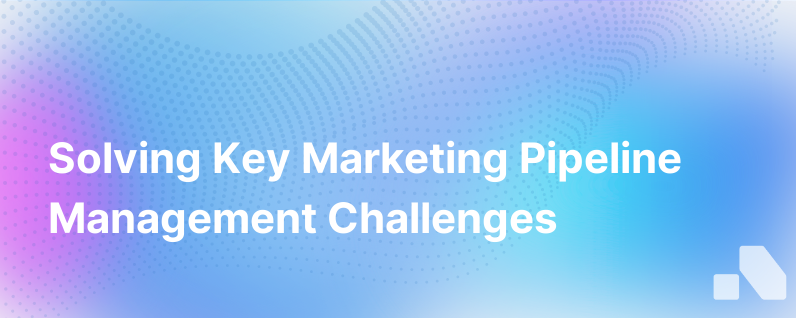3 Marketing Pipeline Management Problems And How To Fix Them
Published on December 17, 2023 by Sawyer Middeleer
Managing a marketing pipeline is akin to conducting an orchestra. Each section, from lead generation to nurturing and eventual conversion, ought to synchronize harmoniously, producing a symphony of sales that propels your business forward. However, in practice, many organizations face substantial challenges that can disrupt this flow, reflect poorly in sales results, and cause a scramble to rethink and repair strategies mid-campaign.
Here, we’ll examine three common pipeline management problems and provide plausible solutions to turn potential discord into productivity.
1. Inaccurate Lead Scoring and Prioritization
The Problem:
Lead scoring, the process of assigning value to each prospect based on their actions and profile, stands as a cornerstone of marketing pipeline management. A primary issue arises when leads are scored improperly or not scored at all, leading to inefficient allocation of sales efforts. Prioritization troubles emerge when teams cannot distinguish between tire-kickers and those on the cusp of purchase decisiveness.
Solutions:
-
Refine Your Scoring Model: Sometimes lead scoring operates on outdated models. To resolve this, you should frequently reassess the qualifications that distinguish a Marketing Qualified Lead (MQL) from a Sales Qualified Lead (SQL). Are they engaging with high-intent content? Have they requested a demo? Scoring models should reflect the evolving journey of your buyer personas.
-
Utilize Predictive Analytics: With AI and machine learning, predictive lead scoring tools can examine historical data and identify patterns that signal a lead’s likelihood to convert. This advanced approach can enhance your prioritization precision significantly.
-
Align Sales and Marketing: It's crucial that marketing and sales share a unified understanding of what scores warrant further attention. Regular interdepartmental meetings can ensure everyone agrees on what constitutes a quality lead.
2. Inconsistent Lead Nurturing
The Problem:
Lead nurturing is fundamental for moving prospects through the funnel, yet it often suffers from inconsistency and improper segmentation, leading to generic communication. When nurturing is misaligned or impersonal, potential buyers, feeling either neglected or bombarded, may stray to more attentive competitors.
Solutions:
-
Automate and Personalize Your Email Sequences: Leveraging marketing automation platforms can send out regular, tailored communications based on where the prospect stands in the buyer’s journey. Segment lists based on behavior, demographics, and engagement, and craft messages that resonate personally with each segment.
-
Content is King: All nurturing efforts should pivot around high-quality, relevant content that addresses prospects’ pain points and provides solutions. A resource library, webinar series, and regular blog posts keep leads engaged and educated, moving smoothly through the funnel.
-
Score Engagement and Adjust Accordingly: Keep an eye on how leads interact with nurturing efforts and score this engagement. A lack of interaction may signal that you need to move an individual into a different drip sequence or try a different mode of communication entirely.
3. Inefficient Funnel Conversion Tactics
The Problem:
Low conversion rates plague many a pipeline. Despite effective lead generation and potential interest, prospects fail to take that final leap to customer status. Perhaps the offers aren’t compelling, or maybe the call-to-action (CTA) is lackluster. In such scenarios, the funnel becomes bloated with unconverted leads, and conversion rates plummet.
Solutions:
-
Optimize Your CTAs: The call to action should be as tailored and targeted as the content preceding it. Each CTA must be clear, compelling, and specific, encouraging leads to take the desired next step without ambiguity.
-
Enhance Sales Enablement: By equipping sales with the right tools—e.g., case studies, whitepapers, tailored presentations—they can engage in more meaningful dialogues with leads, addressing concerns/questions and making a stronger case for conversion.
-
A/B Testing: If you aren’t testing, you aren’t improving. Frequent A/B tests on landing pages, emails, and CTAs can yield data on what resonates best with your audiences. This continual refinement is key to enhancing conversion efforts.
Conclusion:
The pain points of pipeline management are often indications of deeper systemic issues that can derail marketing strategies and sales forecasts. However, these challenges also represent opportunities for refinement and growth. By honing your lead scoring, nurturing efforts, and conversion strategies, you can fortify your pipeline, transforming it into a steady conduit of customers.
In a dynamic and competitive business environment, employing tools and technologies that assist in keeping the pipeline well-managed and efficient can be invaluable. For instance, platforms like Aomni intelligently consolidate customer insights and apply real-time analytics to streamline pipeline management processes, supporting your marketing efforts to engage effectively with leads and expedite their journey from prospect to paying customer.